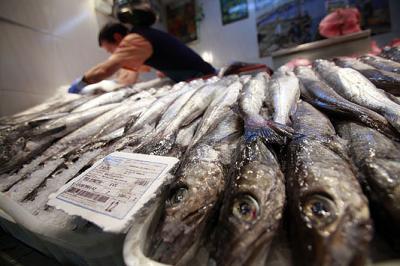The DNA studies carried out by a team of Spanish and Greek researchers, and published in the Journal of Agricultural and Food Chemistry, show that more than 30% of the hake products sold in Spain and Greece are wrongly labelled.
"We have found that hake caught in Africa are being labelled as American or European, meaning consumers pay a higher price for them", Eva García Vázquez, a professor at the University of Oviedo (Spain) and co-author of the study, tells SINC.
The researchers analysed 93 packages of fresh hake and several frozen brands in various hypermarkets between 2004 and 2006. After comparing what appeared on the label with the DNA results, it was found that 31.5% of the batches were mislabelled with the wrong scientific name for the hake, or gave the wrong place of origin.
The study was repeated in 2010 with a further 18 batches, confirming that the information appearing on 38.9% of labels was wrong. For example, species from South Africa, such as Merluccius capensis, were labelled as hake from South America (M. hubbsi) or as the only hake species that exists in European waters (M. merluccius). The worst-labelled products were those containing the fillets or tails of these fish.
This error could be due to confusion during the marking of fish in distribution centres, but it is curious that the "cheap" African hake are the ones that are labelled as the "expensive" European or American ones, and not the other way around, which is why the study suggests that fraud is being committed.
"This fraud only benefits people who sell the product to middlemen, but not the African fishermen or producers, whose low salary is probably what is behind the lower prices of hake from this continent", says García Vázquez.

Hake caught in Africa are being labeled as American or European.
(Photo Credit: SINC)
The prices for the various kinds of hake fluctuate from year to year in international markets, but in general higher prices are paid in Spanish hypermarkets and frozen food stores for European and American hake than for African fish. In 2010, a piece of frozen hake from South America cost an average of €11.72/kg, while African hake cost €6.79/kg.
Similar quality, but people have a right to the truth
García Vázquez stresses that the nutritional properties of all hake species are "practically the same", meaning that consumers have no reason to be concerned about the quality of the product, "but they do have the right to know what species they are eating and where it comes from".
This information takes on greater relevant for people who are allergic to certain species, or at particular times, such as when there are pollution incidents or oil spills in a particular ocean region. Although all fish for sale must undergo regulatory health checks, consumers can decide not to buy hake from the affected area, and for this reason they need to know their truth about where a product comes from.
Regulations require the labels on fish boxes or packaging, be it fresh or frozen, to show the scientific name of the species, its commercial name, the production method (extractive fishing in the case of hake) and the region in which it was caught, among other characteristics. The marine reference areas have been established by the FAO.
Researchers from the Aristotle University of Thessaloniki (Greece) also took part in this study, carrying out the same analyses on hake products in their own country. The results were similar to those found in Spain.
Source: FECYT - Spanish Foundation for Science and Technology